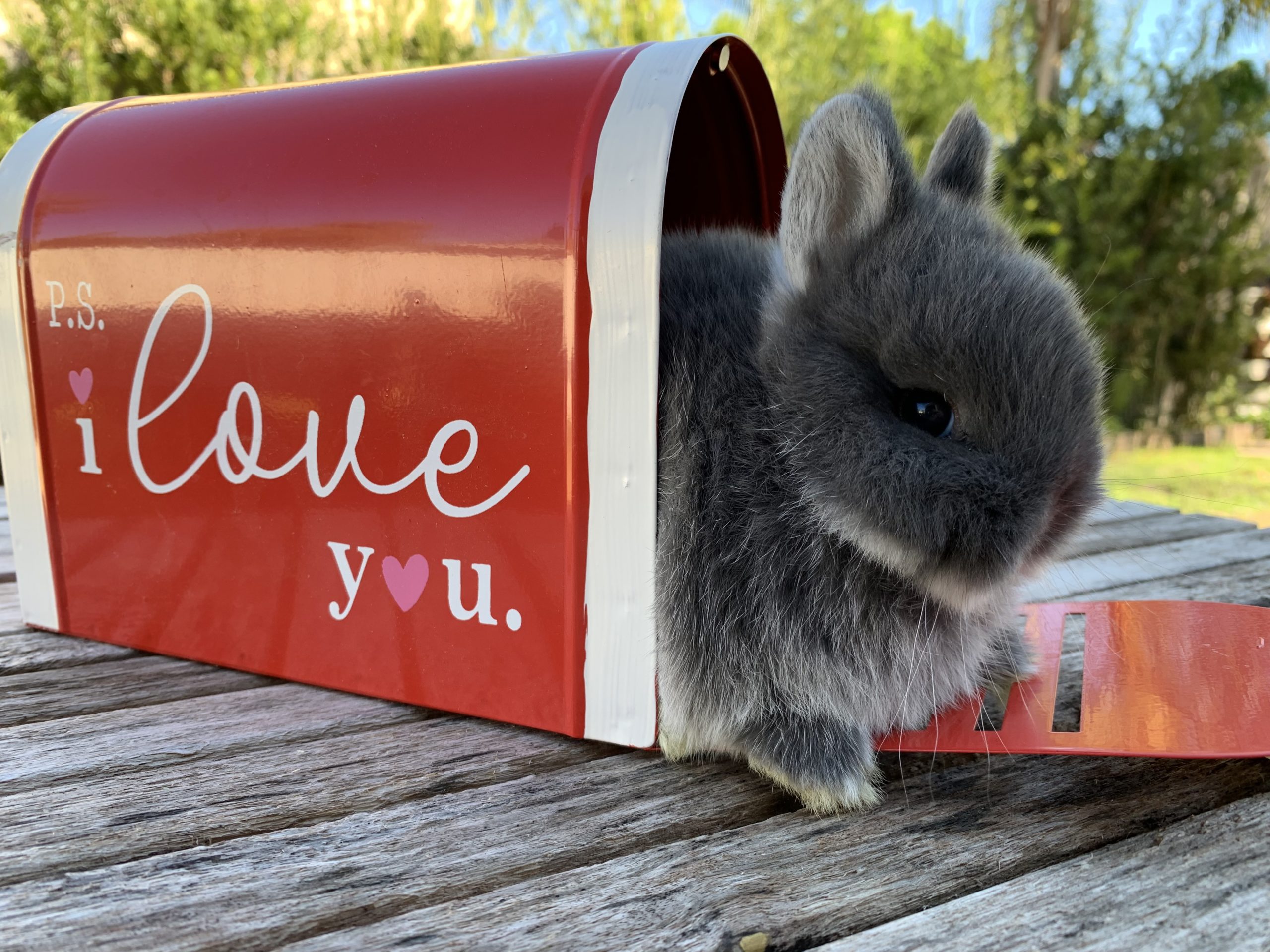Caring for your rabbit
This page contains what we believe are the essentials of bunny care. There are many opinions on how to best care for rabbits and not all of them are incorrect or perfectly correct either, they are just different than what has worked for us and our rabbits.
We suggest you read and practice from various sources until you find what works best for you and your bunny to help you along the way.
Things to know about rabbit care
Indoor habitats for rabbits
We at Sunshine Lops can’t stress enough that you house your rabbits indoors. By adopting this one philosophy, you will always be in close proximity to your rabbit. This one commitment will help ensure your bunny gets plenty of attention, plenty of water and hay, healthy doses of socialization, and ultimately, the best care possible.
For Holland Lops or Netherland Dwarfs we recommend a habitat (often referred to as a cage) that is no less than 30” wide by 24” deep and 18” high. Please pay close attention to the given dimensions of hutches online as these are usually external dimensions and your rabbit may be cramped. Getting the largest hutch on the market isn’t the solution, but don’t get the smallest one either. Click here for a few we have tried and tested for different breeds and living arrangements.
Exercise for rabbits
Rabbits need more activity than what they can get inside their habitat or hutch they live in. Your rabbit needs free time daily to roam, explore, run and exercise. Your rabbit needs a bunny-proof area to play in away from where they sleep at night. For baby bunnies under 8 weeks of age, we suggest a plastic-type exercise pen for pets, not the metal kind we suggest for adult rabbits as babies can squeeze through those too easily but instead a plastic panel pen with very small holes or none at all. Modular playpens give your pet of any age room to run while allowing space for their litter pan, food, water, toys, and even room for his or her favorite human (you) to sit and bond.
If your home doesn’t quite have the space for a playpen, any room that has been bunny-proofed can be used as a spot for your bun to get some well-needed exercise. In the event that you decide to allow your rabbit outdoors to roam, make certain to bunny-proof those areas and always supervise your furry friend as many dangers exist like cats, dogs, other wild predators and birds of prey such as hawks who can all easily injure or even kill your rabbit.
Be mindful that rabbits do not tolerate heat well (over 80 degrees Fahrenheit) so be sure they have access to plenty of shade and water at all times while active outdoors.
Rabbit food bowls
Food bowls, much like water bowls are a matter of pairing the right bowl with the right cage or what we like to refer to instead as your rabbit’s habitat. Some hutches have less space than others and require a hanging bowl for food (and water) and others can simply be in a tip-resistant bowl. We use both types in our rabbitry and there are few drawbacks to either.
Watering your rabbit
Water is the most critical element a rabbit can have and the most destructive if it’s lacking. Never let your rabbit run out of water. Your rabbit’s entire diet, digestion health, and overall well-being are driven by water intake.
Rabbits should have an unlimited supply of water…day, and night. If the container is half full, it is too low already. Refill those containers before you go to work or to bed and check them often just in case it has been leaking, turned over, or become contaminated with rabbit poo.
As to the question about what to use to water my rabbit, there are varying ideas about which method is best, a water bottle or bowl. Both have their own advantages and disadvantages. Sunshine rabbits use various water bottles and water bowls but it mostly depends on the rabbit’s preference and sometimes the type of habitat they live in. We do however see more water consumption with bowls with most of our rabbits. You should experiment and decide for yourself.
Always keep in mind there is more to “watering” than just refilling a container. The bowls or bottles should be cleaned by a human type (you) at least 1-2 times per week and depending on the design of the container, taken apart to remove any algae that will find a home in the small parts of these bottles or dishes.
Litter Boxes
Volumes of books can be written just on rabbits and their bathroom habits. This is one area we suggest you read as much as possible on; right, wrong or otherwise to learn how to control the madness that is known as your bunny’s poop and pee.
Our baby bunnies are provided a proper setup for potty training from month one and they have all learned where to pee and poo by default before they go home at 8 weeks of age or older. Potty training does not mean bunnies won’t pee or poo outside of their litter pan so please be patient, be ready with cleaning supplies, learn and understand your rabbit’s needs, and more than anything, have realistic expectations of rabbit behavior and their bathroom habits.
Rabbits eat their hay and go potty at the same time so make sure you set them up for success. Our best-recommended setup is one small or medium plastic litter pan, equine pellets, and hay.
Watch our YouTube video on how to make a bunny pan here.
Equine pine pellets (aka. horse pellets) absorb urine and control odors from your rabbit’s pee very well. Never use wood shavings for litters as some contain processing toxins that can be harmful to rabbits. Stick with pine pellets. A bag of 40 pounds is $6.99 at your local Tractor Supply Company and one bag will last you a good, long while. We recommend only about 2 cups of pellets per small or medium litter pan when changing your bunz litter pan every other day or if need be, daily.
Brushing
To keep those beautiful coats shiny and clean we use the Glendan Grooming Brush from Amazon because of its super-fine brush pins. Brushing your bunny once a week is a great goal but brush them more when they are shedding, or molting cannot be ignored. Your bunny’s digestive health depends on it.
One other great solution for when you rabbit starts to molt is the SleekEZ Original Deshedding Grooming Tool in the 2.5 inch version to thin your rabbits fur super-easy and safe.
Health
Although Sunshine rabbits are raised in a healthy environment with tons of hay, water and love, all rabbits are susceptible to disease and the stress that accompanies moving to a new home.
We always suggest you make an appointment with a rabbit savvy vet for a simple visit and consultation. Be prepared for them to check your rabbit’s stool, temperature, teeth and other basics to ensure your rabbit has been examined and is a known patient of the vet. In the event you do have any health issues, you and your vet will have a good baseline to work from.
It is also recommended that you spay or neuter your rabbit around 5 to 6 months of age. Around this age hormones begin to display themselves in your rabbit and he or she may become less affectionate and more territorial. This may also help you if your rabbit is still having litter box issues and displaying other unfavorable habits.
Pet Carriers
Before you pick up your bunny from Sunshine Lops, you should consider purchasing a pet carrier for your bun if you don’t already have one. You will use your pet carrier not only to transport your baby bun to his or her new home but also to and from your future vet trips.
Whichever carrier you buy is mostly a personal preference, but we’ll share one of our favorites with you to get you thinking. We like the Akinerri Soft Sided Collapsible Pet Travel Carrier with both a top and side access door. A handle to carry and a shoulder strap as well. Mesh sides help with improved airflow and a cozy, washable mat is perfect for bunz to relax on.

